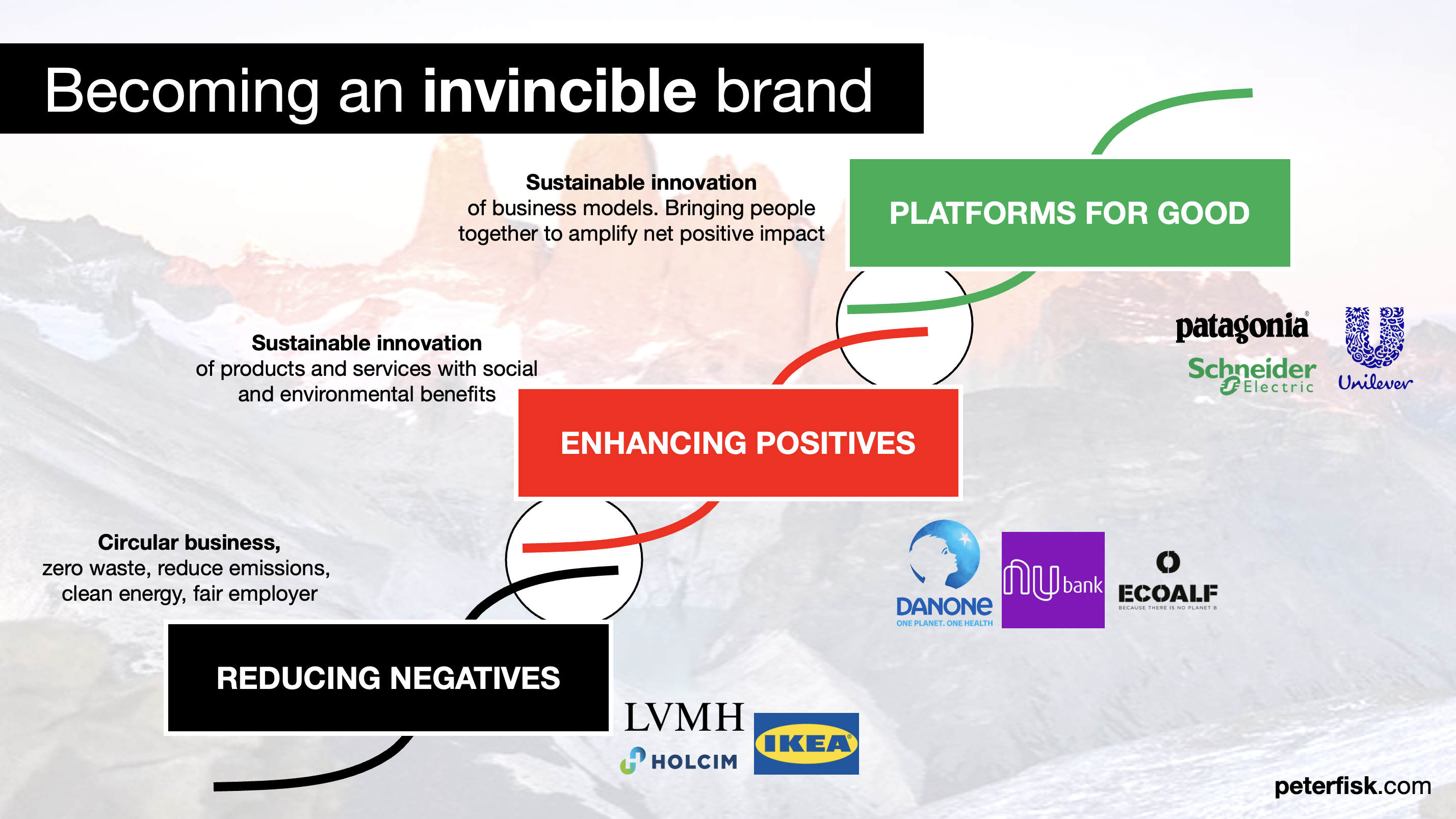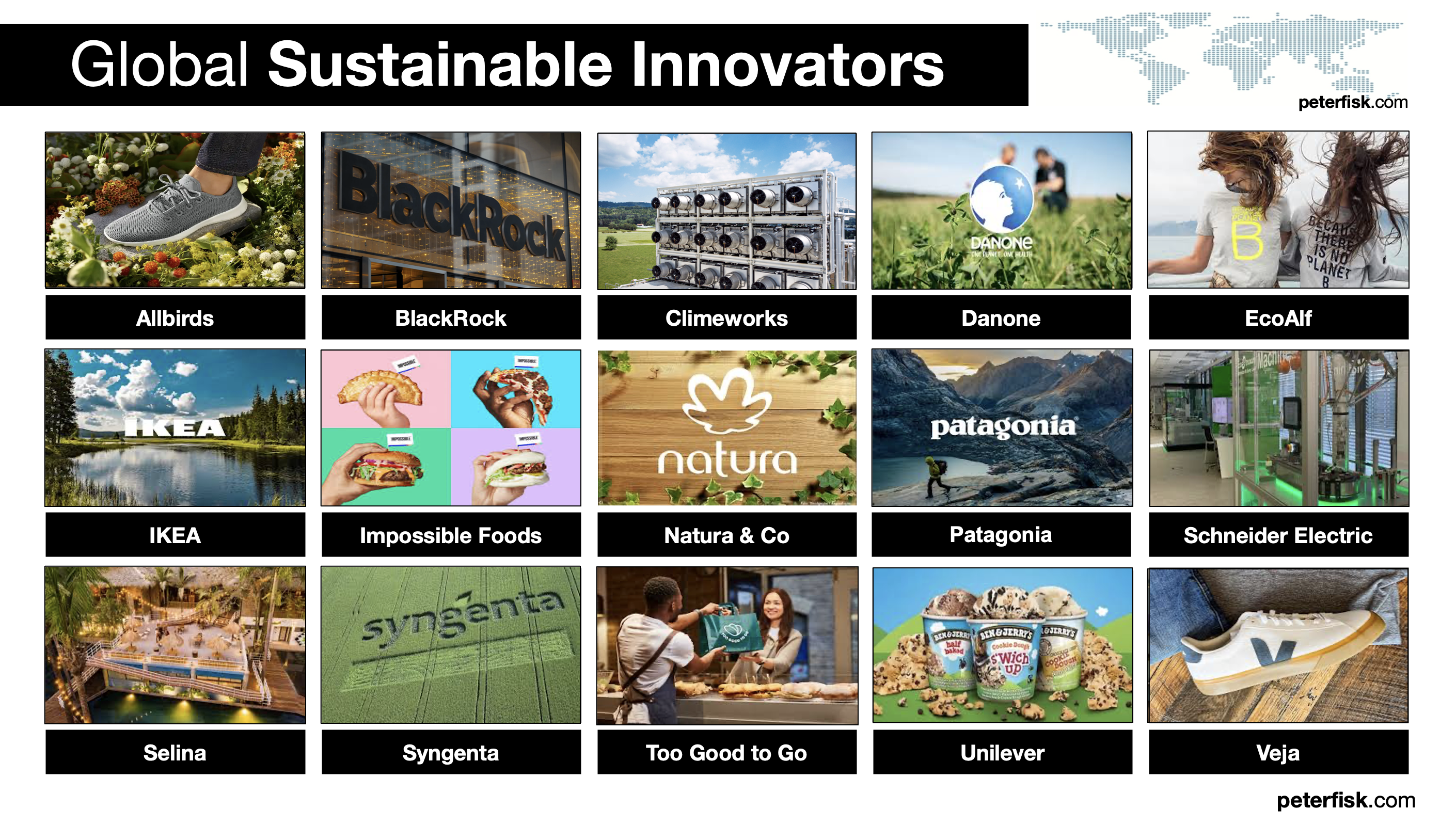The world’s most sustainable innovators … Brands and business using the the biggest problems as their catalysts to innovate and grow with positive impact
August 1, 2024

The world’s most loved brands and businesses succeed not with a single-minded view on financial results – but with more vision, more innovation and more care – and they are often the most valuable too.
Less carbon, less waste, circular business models and social initiatives, are good but not enough. CSR and ESG metrics are important, but could go much further. Sustainability reports are still vanity publications. This is really entry level sustainability.
The best companies embrace sustainability challenges as opportunities for the core business to innovate, to find new ways to grow, and sometimes to fundamentally reinvent itself. Sustainable innovations can often be better than the old products or practices which they replace. Sustainable growth can often faster, and more profitable too.

And while there are fabulous sustainable innovations by start-ups, in needs the audiences and resources of much larger companies to embrace these, and transform their organisations for real impact.

Schneider Electric: Life is On
The French company is a global leader in energy management and automation, and has made significant strides in sustainability, guided by a purpose “to empower people to make the most of their energy and resources, and to bridge progress and sustainability”.
SE’s most distinctive strategy has been to decentralise energy generation and distribution through the use of microgrids, enabling local individuals and communities to generate and share their energy, for consumers to become prosumers. A wide range of solutions help businesses and homes reduce energy consumption. Their products, from smart meters to energy-efficient buildings, help lower carbon emissions. The company invests heavily in renewable energy sources and promotes their use through its energy solutions.
Patagonia’s purpose is to “build the best product, cause no unnecessary harm, and use business to inspire and implement solutions to the environmental crisis.” This mission reflects their commitment to sustainability and environmental stewardship, and they are considered one of the world’s most sustainable brands. The company, founded by Yvon Chouinard in 1973, based in Ventura, California. A certified B-Corporation, is on a mission is to save our home planet.
It prioritises reducing their environmental impact through initiatives like the Worn Wear program, which encourages customers to buy used Patagonia products. The company ensures fair labor conditions in their supply chain, with many of their factories being Fair Trade Certified. They use recycled and organic materials in their products, aiming to create durable, repairable, and recyclable items. Patagonia donates 1% of its annual sales to environmental causes through the 1% for the Planet initiative, and plans to make all of its products by weight from recycled and organic materials by 2025.
The Swedish company’s purpose is “to create a better everyday life for the many people.” This vision goes beyond just selling home furnishings; it aims to have a positive impact on the world, from the communities where they source raw materials to how their products help customers live more sustainably.
It is considered one of the world’s most sustainable innovators. It has set ambitious climate goals, aiming to be climate positive by 2030. This means they plan to reduce more greenhouse gas emissions than they emit. They focus on designing products that can be reused, refurbished, and recycled, minimising waste and promoting resource efficiency. The company uses renewable and recycled materials in their products and aims to phase out single-use plastics, invests in renewable energy sources and energy-efficient technologies in their stores and operations, and ensures fair labour conditions and supports social initiatives, such as providing affordable housing solution.
With a purpose “to make sustainable living commonplace” Unilever seeks to integrate sustainability into every aspect of their business, from product development to supply chain management, and to inspire consumers to adopt more sustainable lifestyles.
Unilever is considered one of the world’s most sustainable brands because if its ambitious goals, including to achieve net zero emissions across its value chain by 2039. They are committed to reducing plastic waste by using more recycled materials and developing innovative packaging solutions. Unilever supports fair trade and ethical sourcing, ensuring that farmers and workers in their supply chain are treated fairly. Through initiatives like the Shakti program, Unilever empowers women in rural communities by providing them with entrepreneurial opportunities.
Harnessing new technologies
While innovations are not just about new technologies, they do provide capabilities to solve the big problems we face in new ways. Here are some of the most exciting sustainable innovations of 2024:
- Sustainable Plastic Alternatives: Innovations aimed at reducing plastic waste by creating biodegradable and compostable materials. eg AirCarbon
- Biodegradable Packaging: New packaging solutions that break down naturally without harming the environment. eg Mori
- Garbage Bins for the Ocean: Devices designed to collect and recycle plastic waste from oceans and waterways. eg Seabin
- Solar Generators: Portable and efficient solar-powered generators for renewable energy on the go.
- Renewable Energy Storage: Advanced storage solutions to capture and store renewable energy more effectively.
- CO2-Reducing Robots: Robots and AI technologies that help reduce carbon dioxide emissions in various industries. eg Kiwibot.
- Zero-Carbon Cement: New methods of producing cement with minimal carbon emissions.
- Microbial Fertilizers: Using microbes to help farmers reduce the need for chemical fertilize
- Carbon-Capturing Microbes: Microbes engineered to capture and store carbon dioxide from the atmosphere.
Building better brands
Developing a sustainable brand typically involves several stages or levels:
- Finding purpose: Understanding the core purpose and mission of your brand. This involves identifying why sustainability matters to your brand and how it aligns with your values.
- Establish priorities: Assessing your current practices and identifying areas for improvement. This step helps you understand your environmental impact and set realistic goals.
- Build a roadmap: Developing a clear strategy and action plan to achieve your sustainability goals, and how they link to business priorities and results.
- Sustainable practices: Integrate basic sustainable practices into your operations, from sourcing materials like clean energy to production and distribution, building a circular model over time.
- Build a platform for good: Engaging with stakeholders, including customers, employees, and partners, to create a community around your sustainable brand.
- Authentic storytelling: Effectively sharing your sustainability journey and achievements with your audience in a way that is real, tangible and useful. Get others to tell the story for you.
- Business dashboard: Continuously track your progress and report on your sustainability efforts to maintain transparency and accountability, and show how they enhance business results too.
- Sustain and evolve: Regularly review and refine your sustainability practices, gradually making them more core to your business model, your competitive advantage and commercial success.
Contact me at peterfisk@peterfisk.com
More free downloads:
- New research: The World’s Most Sustainable Innovators
- New research: Gamechangers Turkey: The Most Sustainable Innovators
- Video: Business for a Better World
- Article: Sustainable Advantage
- Book: People Planet Profit: Sustainable Innovation by Peter Fisk
- New research: Ipsos Global Trends Report
- Resources: Sustainable Futures Project
More from Peter Fisk:
- Keynote speaking: inspiring speaker on future megatrends, disruptive innovation, and courageous leadership
- Business workshops: world class facilitation, applying the most innovative ideas practically
- Executive education: customised, leading edge, in-house programs and with top business schools
- Strategic consulting: expert, collaborative, facilitate support and advice to boards, executives and project teams
More from the blog